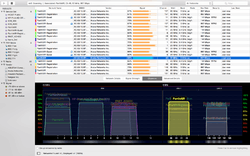WiFi Explorer
 | |
|
WiFi Explorer, version 2.0 running on OS X 10.10.3 | |
| Original author(s) | Adrian Granados |
|---|---|
| Initial release | January 17, 2012 |
| Stable release | 2.0 / May 1, 2015 |
| Preview release | 1.7.2 / November 25, 2014 |
| Development status | Active |
| Written in | Objective-C |
| Operating system | OS X |
| Available in | English, French, Italian, Portuguese, Spanish |
| Type | Wi-Fi network scanner |
| License | Proprietary commercial software |
| Website |
www |
WiFi Explorer is a wireless network scanner tool for OS X that can help users identify channel conflicts, overlapping and network configuration issues that may be affecting the connectivity or performance of IEEE 802.11 wireless networks.
History
WiFi Explorer began as a desktop alternative to WiFi Analyzer,[1] an iPhone app for wireless network scanning that was pulled out from Apple's App Store in March, 2010 due to the use of private frameworks.[2][3] Since its first release, WiFi Explorer incorporated features that were not included in the last available version of WiFi Analyzer, such as support for 5 GHz networks and 40 MHz channel widths. Starting in version 1.5, WiFi Explorer includes support for 802.11ac networks, as well as 80 and 160 MHz channel widths.
Features
- Displays various network parameters:
- Network name (SSID) and MAC address (BSSID)
- Manufacturer
- AP name for certain Cisco and Aruba devices
- Beacon interval
- Mode (802.11a/b/g/n/ac)
- Band (2.4 GHz ISM and 5 GHz UNII-1, 2, 2 Extended, and 3)
- Channel width (20, 40, 80, and 160 MHz)
- Secondary channel offset
- Security mode (WEP, WPA, WPA2)
- Support for Wi-Fi Protected Setup (WPS)
- Supported basic, min and max data rates
- Advertised 802.11 Information Elements
- Graphical visualization of channel allocation, signal strength or Signal-to-noise ratio (SNR)
- Different sorting and filtering options
- Displays signal strength and noise values as percentage or dBm
- Ability to save and load results for later analysis
- Metrics and network details can be exported to a CSV file format
- Selectable and sortable columns
- Adjustable graph timescales
- Editable column for annotations, comments, etc.
- Customizable network colors
- Full screen mode
- Comprehensive application's help
Limitations
Due to limitations of Apple's CoreWLAN framework,[4] WiFi Explorer is unable to detect hidden networks (except when associated) and does not support external (USB) wireless adapters.
System requirements
- OS X 10.7 or higher (64-bit)
See also
- iStumbler - An open source utility for finding wireless networks and devices in Mac OS X.
- KisMAC - A wireless network discovery tool for Mac OS X.
- Netspot - A Mac OS X tool for wireless networks assessment, scanning and surveys.
